Brexit: the macro context
2. Marco
The range of economic outcomes for the UK over the next 12 months is wide. Cushman & Wakefield research, supported by data from Moody’s, suggests annual GDP performance spread is 6%: with remaining in the EU forecast to drive annual GDP growth of 3.8%, which most forecasters while a disorderly no deal would deliver a contraction of -2.2%. A Brexit in name only solution implies growth above 3%.
The wide variety of outcomes in growth projections in the near-term makes devising appropriate strategies for real estate more difficult. “The advice we are giving to clients is to go back to first principles, think about fundamentals and focus on long-term ‘knowns’,” said Elisabeth Troni, head of EMEA research and insight at Cushman & Wakefield in a Brexit webinar.
By 2020, the spread in GDP growth forecasts between the different scenarios evaporates and each converge to baseline trend growth of around 2% per annum. The potential lower outlook for longer term economic growth looks weak by historical standards but could become the ‘new normal’ for the UK, Troni suggests, adding:
“Our peers, the US and the eurozone, are actually doing quite well, one lesson we have learned through the referendum period to today is that Brexit has virtually no impact on the rest of the world. The collateral damage that was expected by forecasters from Brexit has done very little to dent Europe. Europe is holding up quite well which has helped support the baseline growth rate. [The UK] has had a much stronger environment sine the referendum than expected largely because Europe has been less affected by Brexit than we thought.”
Troni added that Cushman & Wakefield is attaching greater probability to a more subdued growth projection of below 2%, which will feel low relative to performance of international peers but avoids a no deal exit. Capital Economics forecast an extension to Article 50 would moderate UK GDP growth in 2019 down 30 basis points to 1.5%, which contrasts sharply with negative growth of -0.2% in a disorderly scenario.
Markets’ rising confidence that a no deal will be avoided prompted the pound to rally 2% last week against the dollar closing Friday at $1.32, its highest since last October.




